|
Aslackby
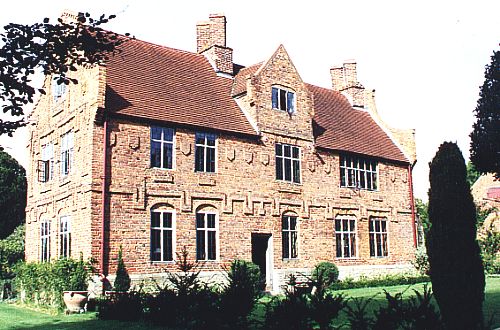
The manor house at Aslackby
A quiet
and scattered farming village called Aslackby can be found seven miles north of Bourne on the A15 although its own people call it
Azelby. It may be connected with another settlement in North Yorkshire that was also spelt
Aislaby in the Domesday Book but is now written as Azleby. This village lies where the high land begins to drop down to the fens and on a fine autumn afternoon, the sun is in the right position in the heavens to bathe the countryside with mellow light and create a colourful landscape portrait of the village from afar with the parish church of St James the Great as the
centrepiece. There is also a quaint-looking public house, memories of
monastic buildings, a castle site and abundant shady trees but there are
no community facilities because the post office closed on Wednesday 27th
March 1991 followed by the village shop the following day.
|
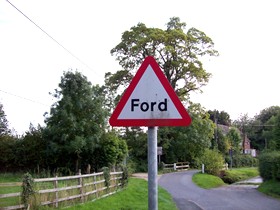 |
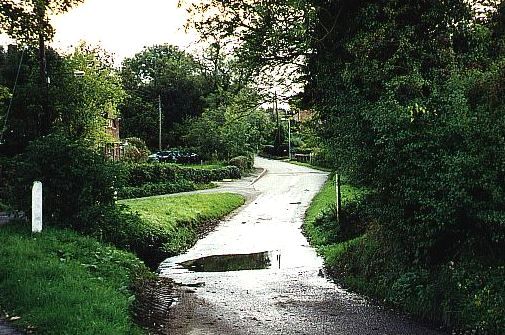 |
|
There is also a ford in the village where one
of the back roads crosses the River Ave
and it is from this point that the visitor will get the best view of
the church with its handsome panelled parapets and 15th century
tower. |
The
church of St James the Great dates from the 14th century but has an 1856 chancel
that has blended well with the mediaeval
parts. Inside, the light streams unhampered through many windows, the east
window containing three emblems which tell much of the village's history. On the left is the red Maltese cross of the Knights Templar, on the right the white on black Maltese cross of the Knights of St John and in the centre is the scallop shell, the badge of pilgrims to the shrine of St James at Compostella in Spain.
The simple walls are unadorned except for a tablet here and there to a soul long departed while in the chancel are more up-to-date insignia in two kneelers: one to celebrate the Queen's Silver Jubilee in 1977 and the other the Royal Wedding of 1981. There are lofty and graceful arcades with moulded arches and tall clustered piers, a narrow tower arch reaching almost to the roof timbers, an old font enriched with tracery, shields and Tudor roses, and a piscina and an aumbry in each of the wide aisles while the south aisle has a doorway to the former rood loft.
|
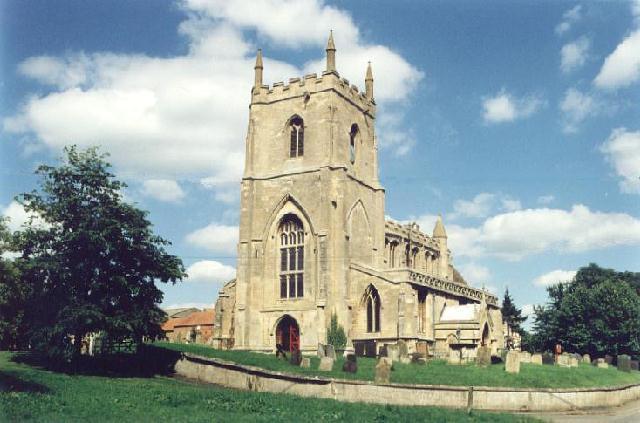 |
|
The magnificent parish church at Aslackby,
standing on rising ground and dominating the village scene, with a
view of the interior (bottom). |
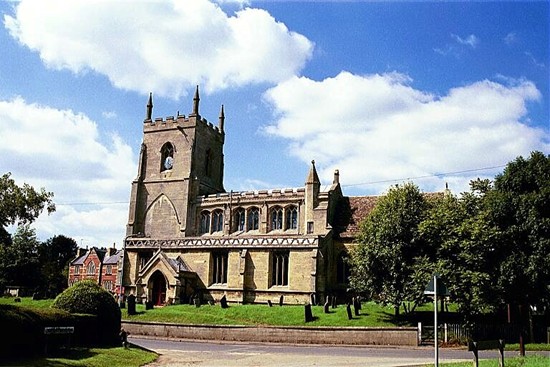 |
|
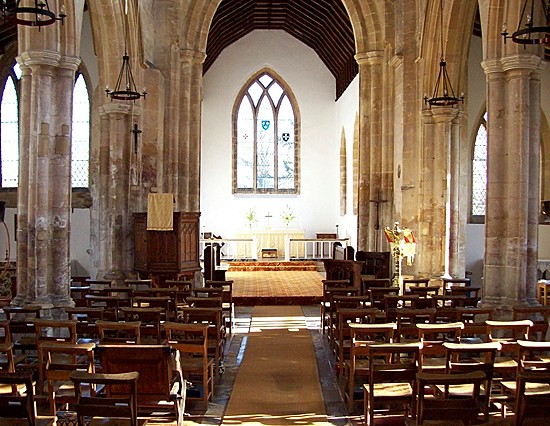 |
On the west wall of the nave are three drawings of a building which was demolished in 1892. In 1843, the gazetteer William White described it as "a square embattled tower of two storeys. The lower storey is vaulted and at the meeting of eight groins in the centre are eight shields of arms, one charged with a cross". He was referring to the 14th century gatehouse tower of the Preceptory of the Knights Templar, founded here about 1154 by Hubert of Rye who gave them their chapel ten years later.
Like other Templar buildings, this was taken by the Crown in 1312 and subsequently passed on to the Knights of St John in 1338. The preceptory church was dedicated to St John and was still being served in 1514 and part of this church survived into the last century. There is a feeling of spaciousness inside the church because there are no pews, only chairs. There have never been pews here and this allows a more flexible use of space. Near to the door is an old stove, a reminder of the way the church was heated in earlier times.
|
COAT OF ARMS RESTORED
|
|
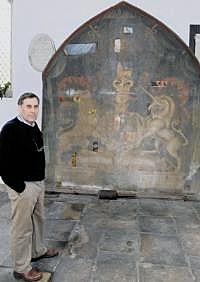 |
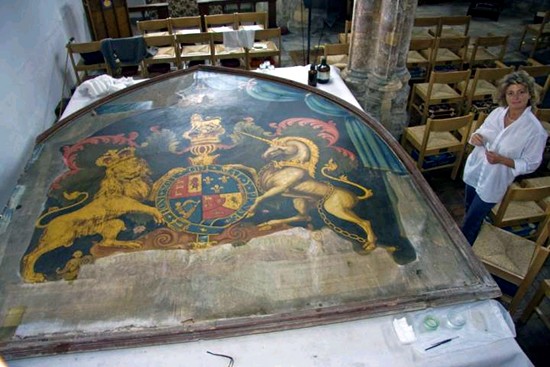 |
|
The parish church also
contains a royal coat of arms, an oil painting on canvas of good
provincial quality dating back to the 18th century, that has been kept in
a storage room for the past 150 years but had begun to deteriorate so
badly that in May 2008, the parochial church council decided to have it
restored. "An opportunity arose to carry out the work as part of a wider
project to improve the church", said churchwarden Chris Gudgin (pictured
above left). "It is a significant part of our heritage that should be properly
preserved and funding is being sought to cover the cost which will be
around £9.000 and should take about three months to complete." The
work was soon underway to restore the coat of arms to its original
splendour (above right) and regular reports on the progress of the work
were made to the Aslackby History Society. |
|
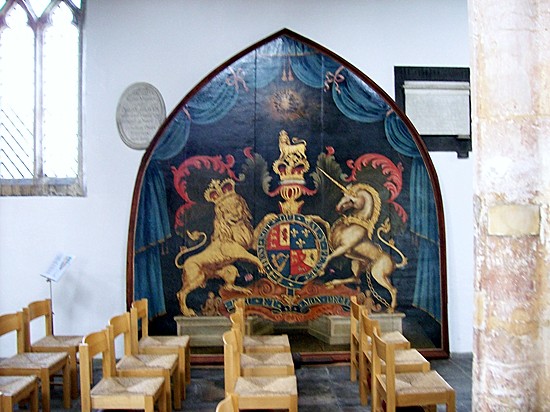 |
There
was also a Methodist church here which was particularly popular during the 19th
century. The cause first arrived in 1800 when John Burrows and his wife moved to
the village from Skillington, near Grantham, having been bequeathed a grazing
farm by Lord Harborough who was appreciative of their faithful work while in his
service. They were devout Methodists and it is from their initiative that local
Methodist communities were subsequently established at Billingborough,
Rippingale, Pointon and Bourne. Burrows invited visiting preachers to address
meetings at his home and by 1802, there were 27 members of the congregation. The
first chapel was built in 1863 at a cost of £92 on a plot of land bought for
£8 and by 1888, the Sunday School had 37 pupils which had risen to 51 in 1920.
|
The old Methodist Chapel at Aslackby which was
established in 1903 after the building was bought for £200 but was
badly damaged by fire in 1952 and later sold for residential
development. |
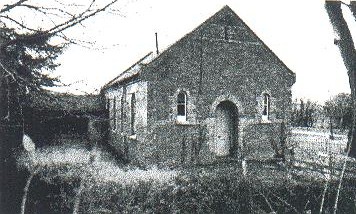 |
By this time, a second larger chapel
had been opened in 1903, the property having been bought
from Mr Smith of Aslackby for £200, and a board of trustees appointed to
run it while the old chapel was subsequently sold on 7th October that year
for £51. 5s. 0d. The new chapel was unique in Methodist circles because
it possessed a full-sized baptistry under the floor. The building was
badly damaged by fire in 1952 and services were temporarily transferred to
the village church. But due to a re-appraisal of resources, the Methodists
eventually decided to concentrate their money elsewhere and the chapel was
closed and offered for sale with restrictions on the supply of alcohol,
gambling and religious activities, and in 1986 it was acquired by a
private buyer and converted into a cottage.
A
mediaeval earth floor was found beneath the village hall during a major
renovation scheme in 2010. The discovery was made by builders while
relaying the stone floor and consisted of layered deposits of straw
believed to date back to Saxon or Norman times. Two other floors had since
been laid on top, a 14th century stone crushed floor and another, also of
crushed stone, completed in Victorian times. Details of the discovery were
recorded for church records before being carefully covered over.
Parishioners had been fund-raising for seven years to modernise the
building at a cost of £6,000 which included the installation of a boiler,
kitchen, toilets and new meeting room.
Temple Farm that can be found to the south west of the village stands on the site of the Knights Templar establishment and there are legends too of an underground passageway existing between here and the church and an even longer one to the priory.
One of
the oldest properties in the village is Monk's Cottage, previously known as
Stone Cottage, and thought to stand on the site of an old Christian burial
ground, perhaps for the Knights Templar, and bones and artefacts are continually
being unearthed in the vicinity, mostly dating back to the 13th century. One
theory is that the cottage once formed part of a chapel but markings on the
stonework indicate that it was from a later period, probably between the 14th
and 17th centuries, while horseshoes and nails that have also been unearthed,
suggest that it may have been used as a forge at some time. Four skeletons
were unearthed during excavations for a kitchen extension in 2000 and they were
dated at between the 11th and 13th centuries and in June 2004, the present
tenants, Rob Andrew and Sharon Paul, found four human skulls while building work
was underway for a new conservatory. The two best preserved contained near-full
sets of teeth and a dental expert identified one as a male in his mid-thirties
and the other as a female in her mid-twenties, both around 800 years old.
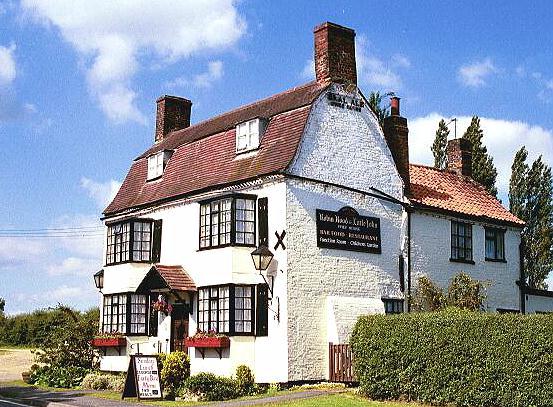
The village pub at Aslackby, the Robin Hood and Little John, stands alongside the main A15 road at the turning off into the village. This ancient inn dates back to Regency times and was a regular watering stop for coaches plying between London and Lincoln. A
favourite verse of past times, often quoted by customers, was:
All you men who think it good
Come have a drink with Robin Hood.
If Robin Hood abroad has gone
Then have a drink with Little John. One of the most interesting manor houses in South Lincolnshire can be found at Aslackby, to the west of the village church. This is a very attractive property of ancient origin, the rear stone wing surviving from an earlier mediaeval manor house while the other shorter east wing was added circa 1650 and is finished in the wildest artisan mannerism decoration with Dutch gables, pilasters and hood-moulds, changing into crenellation and shields, all in crudely cut red brick. The term "artisan mannerism" was coined by the English architectural historian Sir John Summerson (1904-92) whose study Architecture in Britain 1530-1830 is still regarded as the definitive work on the subject.
During the mid-17th century, the appearance of many major country houses departed radically from the vernacular of preceding centuries in this way and the style soon spread throughout the fens and surrounding area as builders of lesser houses followed the fashion for adding pediments and other uncoordinated details, such as brick quoins and string courses, often on the slightest excuse and with little regard for their propriety. The gardens here are an added delight and the public now has a chance to take a close look at this manor house in all of its glory and to learn something of its past as part of the Lincolnshire Heritage Open Days held annually to give visitors the chance to see places of cultural and historic interest in the county.
 |
 |
|
A grand Victorian
house of 1865 (left) and the Georgian rectory (right). |
The old rectory, now a private house, stands between the manor house and the
church and is also in red brick but is late Georgian with attractive blank
arcading on the ground floor. This is also taken up in the adjacent stable
block. These three buildings, church, rectory and manor house, standing on a
rise overlooking the main street, constitute the most attractive part of the
village.
|
THE CHURCHYARD CROSS
The Rev Kenneth Street
(1905-1985) was appointed rector of both Aslackby and the adjoining parish of
Kirkby Underwood in 1959 and remained for almost 25 years. He was
a gifted artist whose paintings often appeared on the front page
of the parish magazine and he was also a wood carver who was
regarded in this field as a talented amateur. The rector designed
and made the processional cross that is still in use in the church
of St Mary and All Saints at Kirkby Underwood and the sign that
hangs on the front wall of the village hall. The churchyard at
Aslackby also contains a tree in the form of a cross (pictured
right), taking literally the
words of the hymn that has the line He hung on the tree.
Originally standing in the midst of a rose bush, now gone, the
inscription is carved on the northern side and on the reverse are the words Simply to thy glory. |
 |
|
It looks out across the bumps and humps
that mark the site of Aslackby Castle, a comparatively short-lived
feature built by the Wakes of Bourne. The rector completed this
cross before he retired in September 1983. His wife Ann later recalled: "My husband tried to keep St James' Church at Aslackby simple and light. When the east window had to be replaced about ten years ago, he suggested the three shields as the only addition. He made the churchyard cross from a dead fir tree and, after de-barking it, carved the inscription on it."
Mrs Street also remembered that a painting of the Knights Templar preceptory at Aslackby by G de Wint exists and was auctioned by Christies in London about 1961 when it fetched 70 guineas although it was wrongly catalogued as Aslackby Church. The current whereabouts of this painting however is unknown.
Mr Street died on 15th August 1985 at the age of 80, having been a priest for 55
years, and is buried in the churchyard at Kirkby Underwood.
For more information
about Kenneth Street see Kirkby
Underwood |
|
ASLACKBY
- from
"Lincolnshire" (published 1836) John Sanders, junior, Lincoln
On the high road from London to Folkingham and Sleaford and
about two miles before you reach Folkingham, you see on the left
lying in a little valley below, the village of Aslackby. And a
true specimen of the old English village it is; sloping fields
dotted with sheep rise around it; a small square embattled tower,
hoary with years, seems guarding it on the right, and amid the
habitations which repose so calmly around the church, as
conscious of its high and solemn purposes, uprears towards Heaven
its simple beauty.
On the left as we enter the village from the high road, we find
this tower, which is all that remains of a preceptory of the
Knights Templars, built in the reign of Richard the Lionhearted.
The interior consists of two stories. The upper one has been
roofed and fitted up as a chamber by the occupant of the
farmhouse adjoining; the lower one, used as a cellar, appears
more in its pristine state; it is vaulted, with groined arches,
having in the centre eight shields bearing various coats of
arms, and upon the middle one a cross. Near to this spot,
according to tradition, a round tower formerly stood, which was
pulled down, and the materials used to construct the farmhouse
above alluded to. This edifice still bears the name that has for
centuries been attached to the spot, viz. The Temple. On one of the
eminences which rise south of the village is said to be the site
of the ancient church of the Templars, and is is certain that
about ten years ago, a stone coffin of large dimensions was dug
up in the adjoining enclosure. There is a tradition among the
villagers of a subterraneous passage from this church to the
temple before-mentioned.
|
Returning thence into the village we find an ancient gateway,
and in the house to which it is attached some perfect armorial
designs, and two very beautiful sun dials, all in stained glass.
About one mile westward, in a field called the Avelands (from
which the hundred derives its name), is a large space of ground
enclosed by a moat; and here, it is said, about a century ago,
the Sessions for this division were opened under a large tree,
no longer standing, and from thence were adjourned to
Folkingham. |
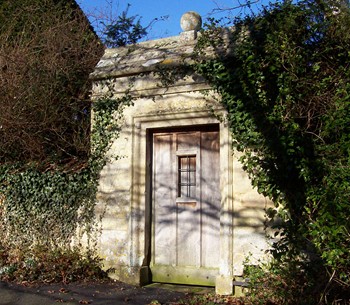 |
The living is a vicarage in the archdeaconry and diocese of
Lincoln, rated in the King's Bench as £12 10s. 1½d.
Population, including the hamlets of Millthorpe and West Graby:
455. |
|
THE PRECEPTORY OF ASLACKBY
This preceptory was founded early in the reign of Henry II for
Hubert of Rye, presented to the Templars the church of Aslackby
with its chapel "in the year when Thomas archbishop of Canterbury
departed from the king at Northampton", that is to say, in 1164.
Margaret de Percy was also a benefactress of the house and so was
John le Mareschall in 1194.
The Templars here were accused in 1275 of holding lands in
Rippingale to the prejudice of the king, and of withholding
sheriff's aid in Dowsby and Rippingale and Gautby.
The house was taken into the king's hands in 1312, but was never
made into a new commandery by the Hospitallers. They held at
Aslackby in 1338 a capital messuage, two carucates of land and a
church, which were farmed to Henry de la Dale, secretary to the
Earl of Lancaster. This property was afterwards made part of the
endowment of Temple Bruer.
Reproduced from Houses of Knights Templars by
William Page (editor), A History of the
County of Lincoln: Volume 2 (1906). |
|
ASLACKBY IN PAST TIMES |
|
 |
|
The main street and village pump circa 1900 |
|
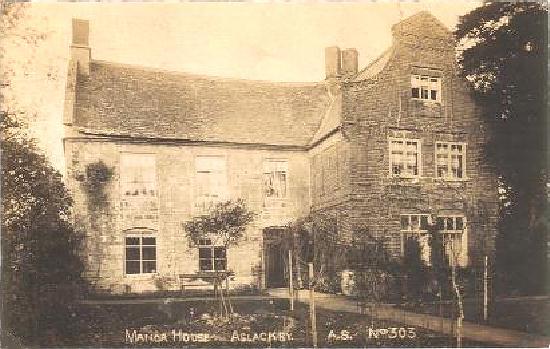 |
|
The Manor House at
Aslackby taken by Ashby Swift, the Bourne photographer, circa
1920. This picture was sent to me by Mrs Pat Edwards of Berwick,
Victoria, Australia, whose great grandmother once lived there.
She was Mary Ann Dale, born around 1855, and the daughter of
local farmer Anthony Dale who owned the property. Local records
show that he was still in occupation in 1876 but had gone by
1885. Mary Ann moved out when she married David Chesman at
Bourne in 1879.
The photograph below of the same aspect of the house was taken
in the summer of 2000 and shows how the brick facade was added
to the original stone building. |
|
 |
|
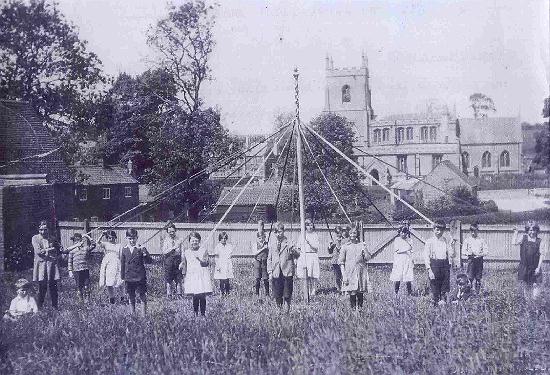 |
|
Maypole dancing by village children at
Aslackby in 1931. They are (left to right) Iris Christian, Lewis
Harrison, Doris Boddy, Sidney Bigley, Hugh Mitchell, Kathleen
Boddy, Mabel Reynolds, Arthur Bates, Wilfred McCallum, Lilian
Pick, Arthur Bell, Meggy Cresswell, Ida Boddy, Fred Cousley,
Alfred Bell and Mary Mitchell. Sitting with tambourines are
Sidney Pugmire and Frank Cousley. The village church can be seen
in the background, the yellow brick Baptist Chapel and George
Stanton's smithy. |
|
 |
|
A village scene from 1908. |
|
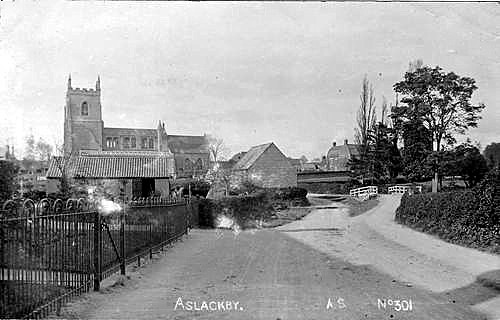 |
|
A picture postcard view of the village from
circa 1930 taken by the Bourne
photographer Ashby Swift. |
|
FROM THE ARCHIVES
|
 |
The Rosseter family of Aslackby and Lincoln came to
Lincolnshire early in the 16th century from Somerset. George Rosseter,
possibly the first to settle, was buried at Aslackby in 1598. There were
also branches of the family at Kirton in Holland, New Sleaford, Lavington
(Lenton), Kirkby Underwood and Quadring. There seems to be no connection
with the Rosseter family of Somerby which had a different coat of arms.
|
|
This family's coat of arms: Argent, on a chevron Gules, three pheons in the
field (three silver pheons - heraldic arrow heads - on a red chevron all
over a silver shield).
|
John, the son of Richard and Elizabeth Brinkley, was
buried, aged 14. He dropt down dead in the road and the coroner's inquest
brought in their verdict: accidental death.
- from the parish registers, 12th October 1758.
On Sunday night the 21st ult. about 8 o'clock, George Gillison, of
Aslackby, was stopped on the Bourne to Folkingham road, near the gate
leading to Graby, knocked down and robbed of eight £1 bank bills and 26
shillings. The pocket book which contained the bills has since been found
in a pasture near the toll bar. - news report from the Stamford
Mercury, Friday 5th March 1819. |
|
MEMORIES OF YESTERDAY'S SCHOOLING |
|
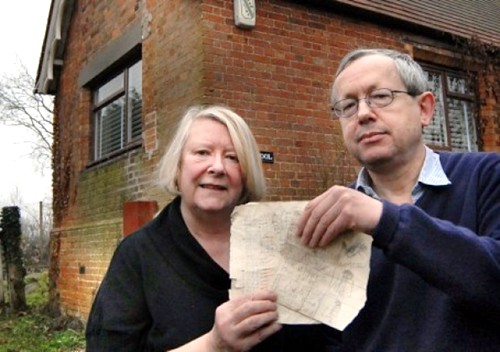 |
|
REPAIRS on a couple’s home during December 2010 uncovered some schoolwork
from wartime pupils at the village school.
Brynley Heaven and his partner, Wendy Thomas, pictured above, live in the old school which
was converted into a house in the late 1960s or early 1970s. Roots from
sycamore trees were undermining one of the walls so they called in the
builders to do some repairs.
They had to knock out part of a wall and found
school work from 1945 under battens on the interior side. Most of it was
devoted to sums, including one asking how many farthings there were in six
old pennies, but there was also a story on Donald Duck and an essay about
a cat called Miss Tibbs.
Brynley and Wendy moved to the house nine years ago. He said: “We
have found four double-sided sheets of school work. It’s anybody’s guess
why they were there. It could have been a naughty child hiding them away
or someone using them to insulate the wall but it is rather appealing to
learn that
someone who would have only been about 11 years old at that
time should be writing about Donald Duck during the dark days of
the war."
The school work is in remarkably good condition considering it is so old. “It is
nothing more than a souvenir but a very touching one", said Brynley.
"Sadly, there are no names on the work because it would have been a
bonus to trace the author.” |
|
PHOTO ALBUM |
|
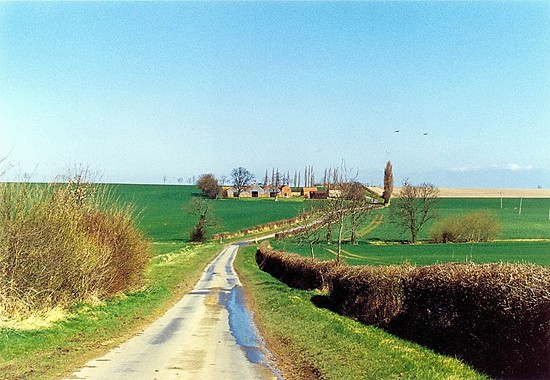 |
|
There can be no greater pleasure than leaving the
main roads in the fens and driving through byways usually confined to farm
vehicles such as this old Roman road to the north of Aslackby where there
is a peace and quiet in the countryside unknown in urban areas. |
See also
One of the best churches in England
John Bigley
Aslackby flooding in July 2007

Go to:
Main Index Villages
Index
|





















